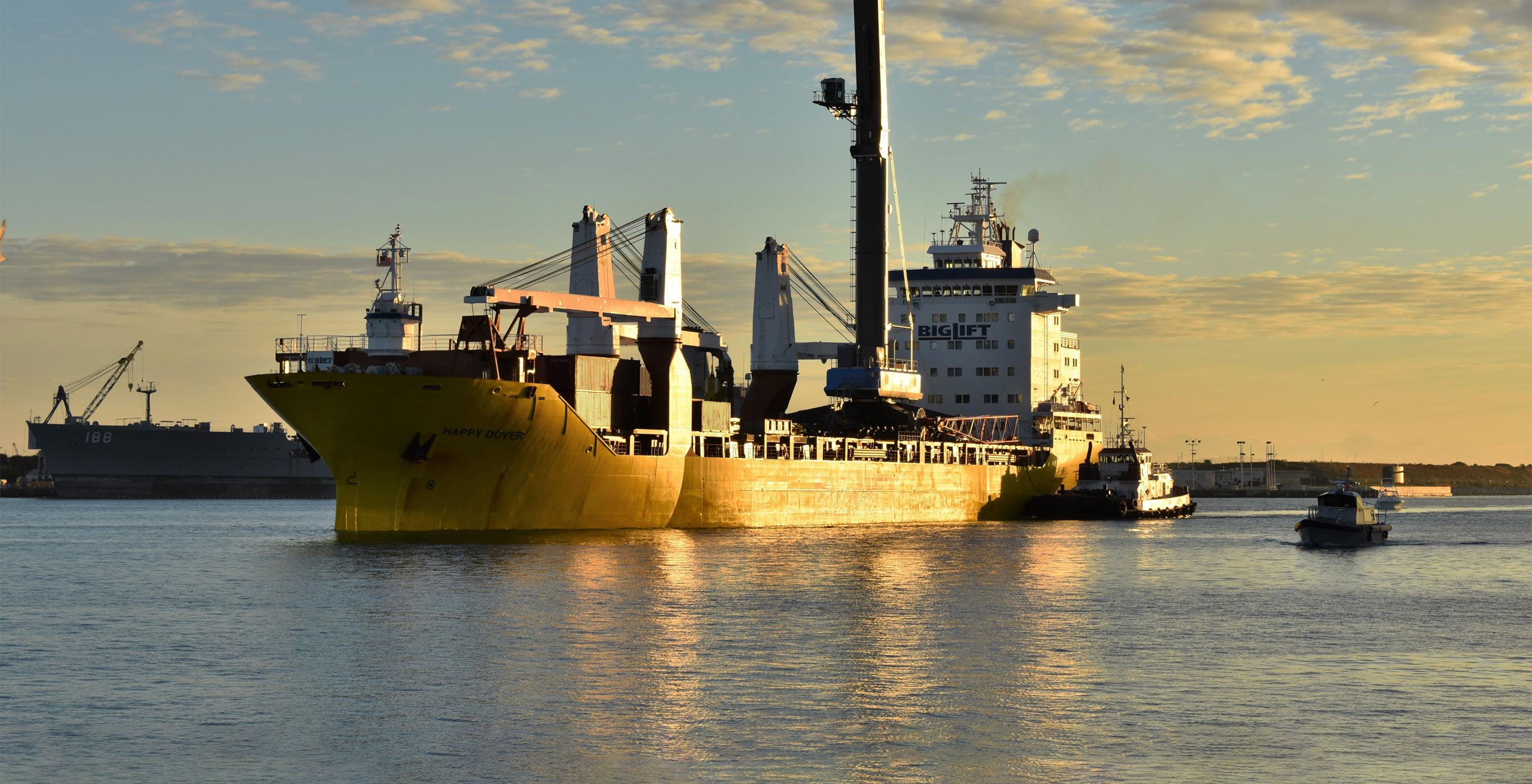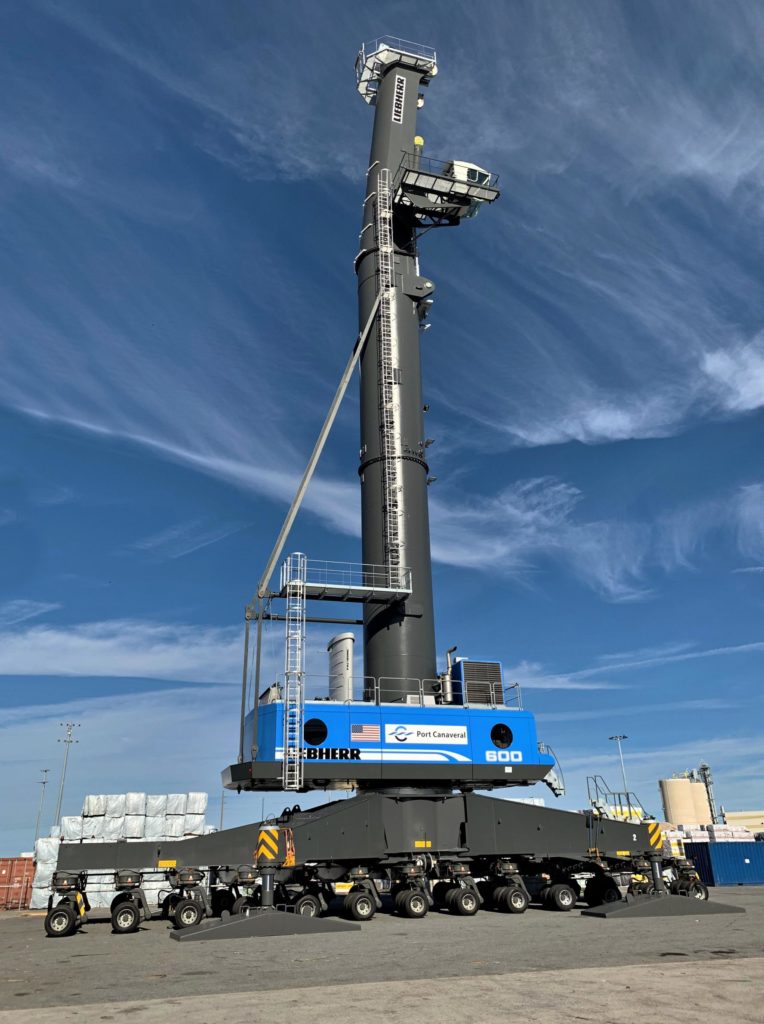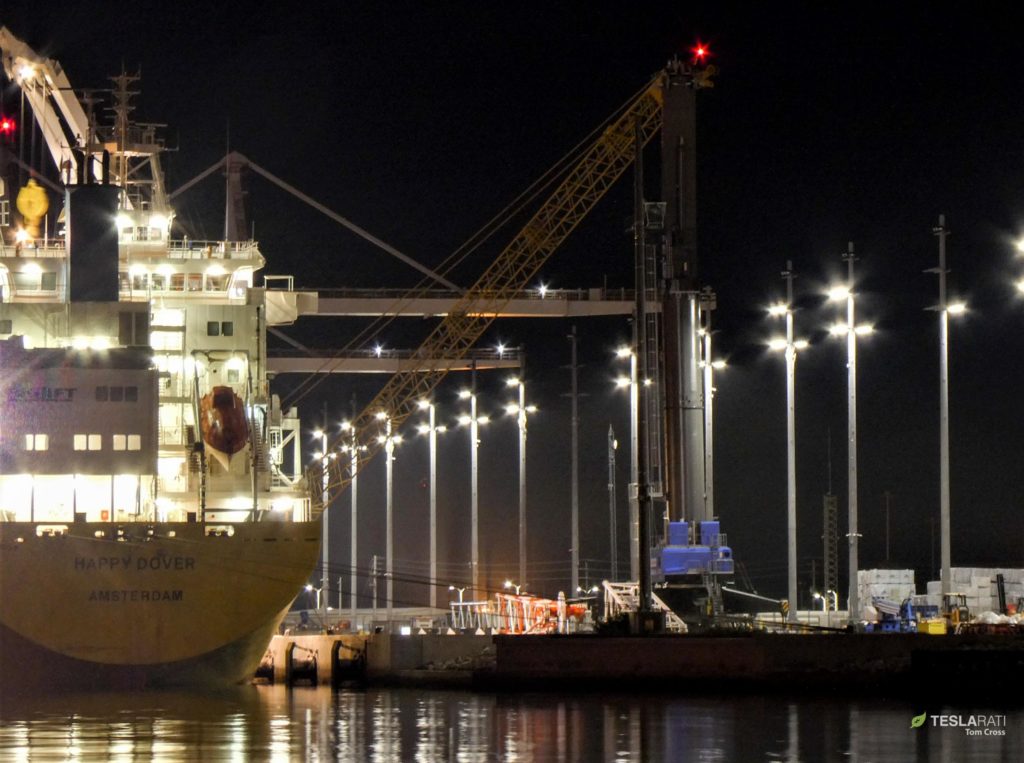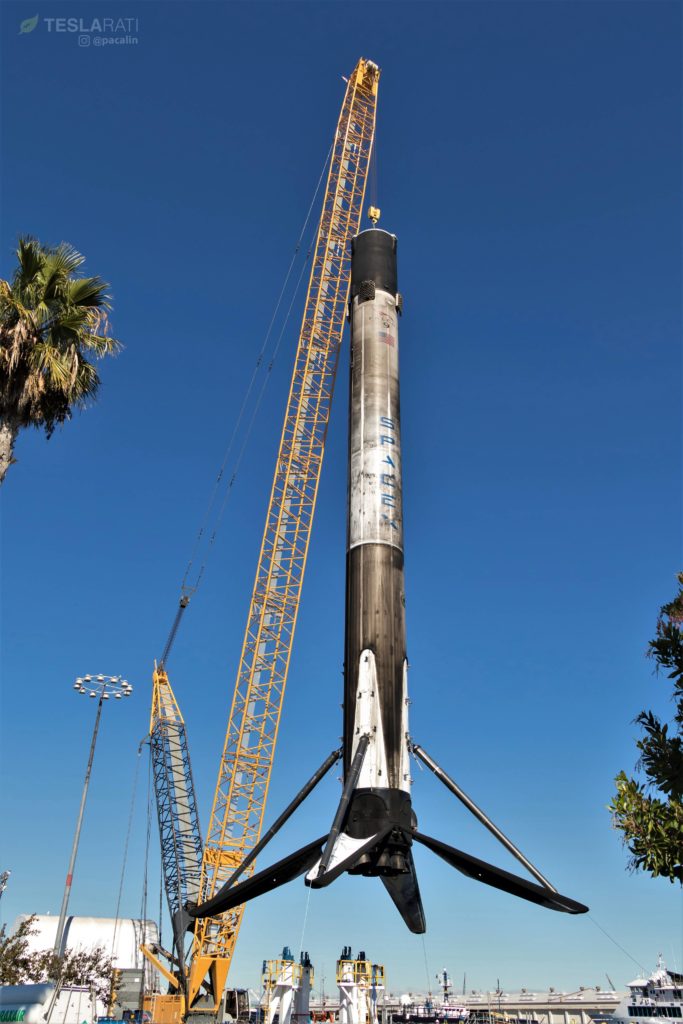

News
Future SpaceX & Blue Origin rocket recoveries may use largest mobile crane in the US
Florida’s Canaveral Port Authority took delivery of what is now the largest mobile crane on U.S. soil, originally purchased in order to support both extremely large cargo ships (known as New-Panamax-class) and the unique needs of orbital-class rocket recovery operations for SpaceX’s Falcon 9 and Falcon Heavy and Blue Origin’s prospective New Glenn launch vehicle.
While there’s a good chance that SpaceX will avoid changing their current Port Canaveral recovery operations and the complement of cranes they already lease or own, Blue Origin will almost certainly take advantage of Port Canaveral’s vast new crane, capable of lifting more than 200 metric tons (~450,000 lbs) at heights greater than 50 meters (160 ft).
I know @AstroVicnet had some questions about the new mobile crane and how it will be used in Port Canaveral. Here is an explainer and how it connects to our Spaceport partners like @SpaceX and @blueorigin. #SpaceXFleet https://t.co/UQqItZbdIr
— Julia Bergeron (@julia_bergeron) January 19, 2019
To put the scale of the crane (and perhaps SpaceX and Blue Origin rockets) into perspective, Falcon 9’s booster – on its own – stands an incredibly 45m (~150 ft) tall or almost the same height as the LHM 600’s main boom (the gray cylinder/tower in the photos above), while Blue Origin’s New Glenn first stage – set to debut as early as 2021 – would tower an extraordinary 57.5m (~190 ft) tall, probably 60m if its small legs are deployed. While SpaceX’s BFR booster (now Super Heavy) is expected to attempt recoveries on the actual launch pad mount, it would stand around 63m (~210 ft) tall. New Glenn and Super Heavy are likely to weigh 50-150+ tons empty.
COLOSSAL CRANE ARRIVES: A 270-foot-tall mobile harbor crane billed as the largest in the United States sails into Port Canaveral aboard the cargo vessel Happy Dover on Friday morning. The 87-foot-long, 1.1-million-pound Liebherr LHM 600 is set to go into service later this year. pic.twitter.com/51DP8Hdb0w
— Port Canaveral (@PortCanaveral) January 18, 2019
The point is that for monolithic objects that are as tall as large rocket boosters, the logistics of actually moving them around can be surprisingly complex and challenging. SpaceX’s Falcon 9 and Heavy boosters happen to be short enough to be conveniently moved and manipulated by cranes that are quite large but still fairly common and easy enough to lease or purchase. SpaceX consistently uses similar tall, yellow cranes for the process of actually lifting Falcon 9 boosters – around 30t (~66,000 lbs) dry – off of their drone ships and onto land, while far smaller wheeled cranes can be used for the process of manipulating Falcon boosters once they are horizontal.
Given just how relatively light Falcon boosters are compared to their towering height, the cranes that can safely lift such tall and delicate objects tend to be designed to easily lift 5-10X as much weight at once. The next-generation rocket boosters (and even SpaceX’s Starship upper stage) will continue to push the height performance and begin to test the mass capabilities of modern cranes, particularly mobile varieties like the one that just arrived in Port Canaveral. One massive benefit of wheeled cranes like LHM 600 is how versatile and flexible they are, while tracked cranes like the largest ones SpaceX currently uses simply can’t move without risking the destruction of the ground beneath them, requiring that they use advanced mass-spreading technologies (i.e. giant beams of hardwood) wherever they crawl.
- Another view of Port Canaveral’s shiny new LHM 600 crane shortly after arriving ashore. (Canaveral Port Authority)
- Teslarati photographer Tom Cross managed to catch Port Canaveral’s new crane shortly after sunset, January 18th. (Tom Cross)
- One of several large cranes used by SpaceX to vertically transport Falcon 9 and Falcon Heavy boosters is pictured here during third recovery of Falcon 9 B1046, December 2018. (Pauline Acalin)
- New Glenn is a massive reusable rocket that will stand ~82m (270 ft) tall and be able to launch up to 45 metric tons (100,000 lb) to low Earth orbit (LEO). (Blue Origin)
Liebherr’s mobile harbor cranes offer a far more mobile solution in the form of traditional rubber tires and multiple large spreader plates that can be deployed and retracted when stationary. It will be genuinely interesting to see if SpaceX decides to replace its proven modes of vertical-lift recovery operations to gain the benefits of a crane that is new and an unknown quantity but could still simplify certain recovery operations. Perhaps even more importantly, the Canaveral Port Authority owns the new crane and apparently bought it with the specific intention of allowing companies like SpaceX and Blue Origin to use it – presumably for a reasonable fee – to assist during rocket recovery operations.
News
Tesla begins Robotaxi certification push in Arizona: report
Tesla seems serious about expanding its Robotaxi service to several states in the coming months.

Tesla has initiated discussions with Arizona transportation regulators to certify its driverless Robotaxi service in the state, as per a recent report from Bloomberg News. The move follows Tesla’s launch of its Robotaxi pilot program in Austin, Texas, as well as CEO Elon Musk’s recent comments about the service’s expansion in the Bay Area.
The Arizona Department of Transportation confirmed to Bloomberg that Tesla has reached out to begin the certification process for autonomous ride-sharing operations in the state. While details remain limited, the outreach suggests that Tesla is serious about expanding its driverless Robotaxi service to several territories in the coming months.
The Arizona development comes as Tesla prepares to expand its service area in Austin this weekend, as per CEO Elon Musk in a post on X. Musk also stated that Tesla is targeting the San Francisco Bay Area as its next major market, with a potential launch “in a month or two,” pending regulatory approvals.
Tesla first launched its autonomous ride-hailing program on June 22 in Austin with a small fleet of Model Y vehicles, accompanied by a Tesla employee in the passenger seat to monitor safety. While still classified as a test, Musk has said the program will expand to about 1,000 vehicles in the coming months. Tesla will later upgrade its Robotaxi fleet with the Cyercab, a two-seater that is designed without a steering wheel.
Sightings of Cybercab castings around the Giga Texas complex suggests that Tesla may be ramping the initial trial production of the self-driving two-seater. Tesla, for its part, has noted in the past that volume production of the Cybercab is expected to start sometime next year.
In California, Tesla has already applied for a transportation charter-party carrier permit from the state’s Public Utilities Commission. The company is reportedly taking a phased approach to operating in California, with the Robotaxi service starting with pre-arranged rides for employees in vehicles with safety drivers.
News
Tesla sets November 6 date for 2025 Annual Shareholder Meeting
The automaker announced the date on Thursday in a Form 8-K.

Tesla has scheduled its 2025 annual shareholder meeting for November 6, addressing investor concerns that the company was nearing a legal deadline to hold the event.
The automaker announced the date on Thursday in a Form 8-K submitted to the United States Securities and Exchange Commission (SEC). The company also listed a new proposal submission deadline of July 31 for items to be included in the proxy statement.
Tesla’s announcement followed calls from a group of 27 shareholders, including the leaders of large public pension funds, which urged Tesla’s board to formally set the meeting date, as noted in a report from The Wall Street Journal.
The group noted that under Texas law, where Tesla is now incorporated, companies must hold annual meetings within 13 months of the last one if requested by shareholders. Tesla’s previous annual shareholder meeting was held on June 13, 2024, which placed the July 13 deadline in focus.
Tesla originally stated in its 2024 annual report that it would file its proxy statement by the end of April. However, an amended filing on April 30 indicated that the Board of Directors had not yet finalized a meeting date, at least at the time.
The April filing also confirmed that Tesla’s board had formed a special committee to evaluate certain matters related to CEO Elon Musk’s compensation plan. Musk’s CEO performance award remains at the center of a lengthy legal dispute in Delaware, Tesla’s former state of incorporation.
Due to the aftermath of Musk’s legal dispute about his compensation plan in Delaware, he has not been paid for his work at Tesla for several years. Musk, for his part, has noted that he is more concerned about his voting stake in Tesla than his actual salary.
At last year’s annual meeting, TSLA shareholders voted to reapprove Elon Musk’s compensation plan and ratified Tesla’s decision to relocate its legal domicile from Delaware to Texas.
Elon Musk
Grok coming to Tesla vehicles next week “at the latest:” Elon Musk
Grok’s rollout to Tesla vehicles is expected to begin next week at the latest.

Elon Musk announced on Thursday that Grok, the large language model developed by his startup xAI, will soon be available in Tesla vehicles. Grok’s rollout to Tesla vehicles is expected to begin next week at the latest, further deepening the ties between the two Elon Musk-led companies.
Tesla–xAI synergy
Musk confirmed the news on X shortly after livestreaming the release of Grok 4, xAI’s latest large language model. “Grok is coming to Tesla vehicles very soon. Next week at the latest,” Musk wrote in a post on social media platform X.
During the livestream, Musk and several members of the xAI team highlighted several upgrades to Grok 4’s voice capabilities and performance metrics, positioning the LLM as competitive with top-tier models from OpenAI and Google.
The in-vehicle integration of Grok marks a new chapter in Tesla’s AI development. While Tesla has long relied on in-house systems for autonomous driving and energy optimization, Grok’s integration would introduce conversational AI directly into its vehicles’ user experience. This integration could potentially improve customer interaction inside Tesla vehicles.
xAI and Tesla’s collaborative footprint
Grok’s upcoming rollout to Tesla vehicles adds to a growing business relationship between Tesla and xAI. Earlier this year, Tesla disclosed that it generated $198.3 million in revenue from commercial, consulting, and support agreements with xAI, as noted in a report from Bloomberg News. A large portion of that amount, however, came from the sale of Megapack energy storage systems to the artificial intelligence startup.
In July 2023, Musk polled X users about whether Tesla should invest $5 billion in xAI. While no formal investment has been made so far, 68% of poll participants voted yes, and Musk has since stated that the idea would be discussed with Tesla’s board.
-

 Elon Musk1 week ago
Elon Musk1 week agoTesla investors will be shocked by Jim Cramer’s latest assessment
-

 Elon Musk20 hours ago
Elon Musk20 hours agoxAI launches Grok 4 with new $300/month SuperGrok Heavy subscription
-

 Elon Musk3 days ago
Elon Musk3 days agoElon Musk confirms Grok 4 launch on July 9 with livestream event
-

 News7 days ago
News7 days agoTesla Model 3 ranks as the safest new car in Europe for 2025, per Euro NCAP tests
-

 Elon Musk2 weeks ago
Elon Musk2 weeks agoA Tesla just delivered itself to a customer autonomously, Elon Musk confirms
-

 Elon Musk1 week ago
Elon Musk1 week agoxAI’s Memphis data center receives air permit despite community criticism
-

 Elon Musk2 weeks ago
Elon Musk2 weeks agoTesla’s Omead Afshar, known as Elon Musk’s right-hand man, leaves company: reports
-

 News2 weeks ago
News2 weeks agoXiaomi CEO congratulates Tesla on first FSD delivery: “We have to continue learning!”





















